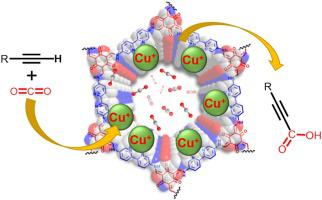Molecular Catalysis ( IF 3.9 ) Pub Date : 2020-12-14 , DOI: 10.1016/j.mcat.2020.111319 Ran Bu , Lin Zhang , Lu-Lu Gao , Weng-Jie Sun , Shuai-Liang Yang , En-Qing Gao

|
The carboxylation of terminal alkynes with CO2 is an attractive route for CO2 fixation and conversion, and various homogeneous Cu(I) catalysts have been explored for the reaction. However, it is still a challenge to develop efficient heterogeneous catalysts for the conversion under mild conditions. Considering that covalent organic frameworks (COFs) are emerging as versatile platforms for the design of functional materials, we developed a TpBpy-supported Cu(I) catalyst, where TpBpy is a stable imine-type porous COF furnished with rich N,N- and N,O-chelating sites for Cu(I) immobilization. The hybrid material can efficiently catalyze the conversion of CO2 and terminal alkynes to propiolic acids under relatively mild conditions (1 atm CO2, 60 ℃). The catalytic activity arises from the synergy between the organic framework of TpBpy and the Cu(I) sites. Not merely serving as a porous support to afford isolated and accessible Cu(I) sites, the organic framework itself has its own catalytic activity through the polar and basic N and O functional sites, which could activate the C–H bond and facilitate CO2 absorption. In addition, the framework also serves as a giant ligand to shift the reversible Cu(I)-catalyzed process in favor of carboxylation. The catalyst shows somewhat reduced activity after reused for three cycles owing to the oxidation of Cu(I) to Cu(II), but it can be easily regenerated by treating with KI.
中文翻译:

铜(I)修饰的共价有机骨架,可将CO 2插入末端炔烃
末端炔烃与CO 2的羧化是CO 2固定和转化的一种有吸引力的途径,并且已经探索了各种均相的Cu(I)催化剂用于该反应。然而,开发在温和条件下转化的有效多相催化剂仍然是一个挑战。考虑到共价有机骨架(COF)逐渐成为功能材料设计的通用平台,我们开发了TpBpy负载的Cu(I)催化剂,其中TpBpy是稳定的亚胺型多孔COF,配有丰富的N,N-和N,O-螯合位点用于固定Cu(I)。该杂化材料可以有效地催化CO 2的转化。和相对温和的条件下末端炔的丙炔到氨基酸(1个大气压的CO 2,60℃)。TpBpy的有机骨架与Cu(I)位点之间的协同作用产生了催化活性。有机骨架本身不仅可以作为多孔载体提供隔离的和可接近的Cu(I)位置,而且还具有通过极性和碱性N和O功能位点自身的催化活性,这可以激活C–H键并促进CO 2吸收。此外,该骨架还可以作为巨大的配体来改变可逆的Cu(I)催化过程,从而有利于羧基化。由于Cu(I)氧化成Cu(II),在重复使用三个循环后,该催化剂的活性有所降低,但是可以通过KI处理轻松再生。











































 京公网安备 11010802027423号
京公网安备 11010802027423号